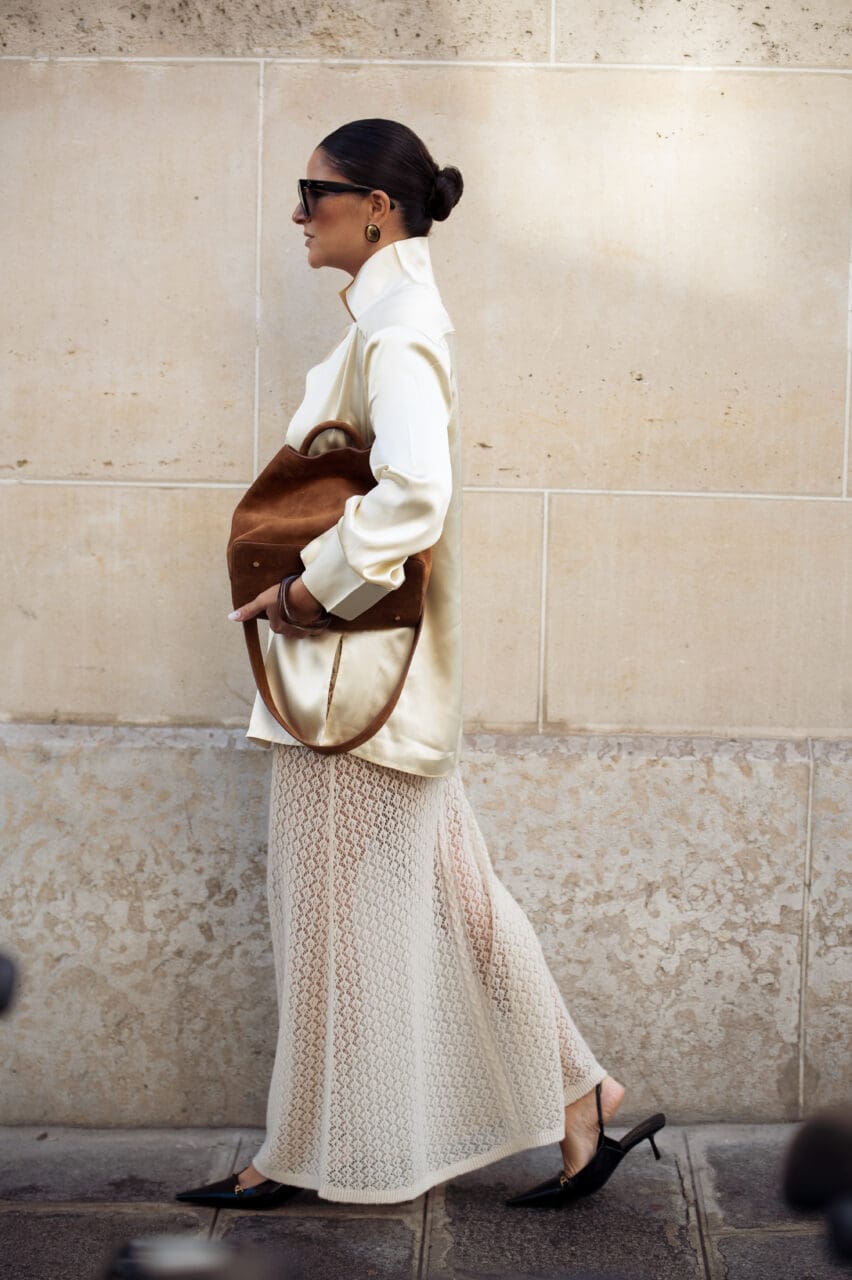Hanae Mori, once Japan’s most famed designer, has died. She was 96 years old.
Mori might be one of fashion’s biggest success stories, though her story is little known today. The designer retired after presenting her final couture collection, for fall 2004, but by then her traditional and feminine work, which often combined Eastern motifs with Western silhouettes, had long ceased to be newsmaking. This was not for lack of quality or skill, rather the image of Japan that Mori represented had been superseded by new values and approaches to design.
The abridged history of fashion dates the rise of Japanese fashion in Europe to 1981 when Rei Kawakubo and Yohji Yamamoto made their Paris debuts, but they might be described as the third wave, having been preceded by Issey Miyake and others, who walked through the door opened by Mori. “When Kenzo, Kansai Yamamoto, and Issey Miyake were all students of design, they used to visit me frequently at my studio,” Mori said in a 1982 interview.

Madame Yukawa (right), wife of the Japanese Ambassador, talking to designer Hanae Mori and a group of models, during a private fashion show in the garden of the Japanese Embassy, London, March 2nd 1972
Photo: Douglas Miller via Getty Images
A Hanae Mori fashion show in Tokyo, 1976
Photo: Kaku KURITA via Getty Images
In 1965 Mori became the first Japanese designer to show in New York; in 1977 she presented her first couture collection in France and was the first Japanese member of the Chambre Syndicale de la Couture Parisienne. She actively encouraged cross-cultural exchange, sharing models, including Hiroko Matsumoto, with Pierre Cardin and Yves Saint Laurent. (Matsumoto would later appear in Francois Truffaut’s 1970 movie Bed & Board, which featured designs by Mori.)
“It was necessary for Mrs. Mori…to travel abroad to win recognition for her work. This was also true of designers who followed her, including Issey Miyake and Kansai Yamamoto,” noted the New York Times. But throughout her career Mori was as focused on influencing how Japanese women dressed as she was on exporting Japanese fashion abroad. “Her idea was to create something original of herself and of Japan,” her husband once said.

Princess Caroline and Princess Grace de Monaco wearing Hanae Mori at the Paris Monte-Carlo hotel in Monaco, August 8, 1977
Photo: Patrice PICOT via Getty Images
Hanae Mori, New York, 1987.
Photo: Susan Wood via Getty Images
Born in 1926 in Mukaichi, Shimane Prefecture, Mori was the daughter of stylish parents, a doctor (who hoped his daughter would follow him into the profession) and a homemaker. “We were the only ones in my hometown who dressed Western-style. It was embarrassing for me as a child to be different, but I guess we were rather envied, too,” she told the AP in 1996. In occupied Japan she read Gone With the Wind and at some point observed the wives of the Allies altering their Western clothes for fit. Post-war, Mori completed a degree in Japanese literature at Tokyo Women’s Christian University, then married the scion of a textile manufacturer, the “liberated (in her words) Kenzo Mori. “I was a very nice housewife for one month, but I did not like to be at home. I wanted to be working, so I ask my husband—he’s Japanese, very strong but very nice—and we discussed it for a month. Then I went to designing school in Tokyo.”
In 1951 she started working over a noodle shop with two assistants and three used sewing machines. About four years later her short-skirted designs were discovered in a shop window by a bunch of businessmen. The next day, one of them, a director, came back and asked her to create costumes, and for about five years Mori, as The Newsweek Service put it, “was the Edith Head of the Japanese film industry.” By 1960, Mori was a mother of two and thinking of walking away from it all, but she claimed that a fitting with Coco Chanel (Mori was the client), where they came to a compromise over the orange the Frenchwoman wanted her to wear, and the black that Mori preferred, put her back on course. “That meeting was fateful,” she’d later say. “I was back in the couture mood again and wanted to set up shop in Paris.”

The newly wed Crown Prince Naruhito and his wife, Crown Princess Masako pose for photographs June 9, 1993 after their wedding ceremony at the Tokyo Imperial Palace.
Photo: TOSHIFUMI KITAMURA via Getty Images
Mori counted Princess Grace, Nancy Reagan Bianca Jagger, and Crown Princess Michiko who wore a Mori dress on her wedding day, as clients. Vogue featured the work of the “famous-in-America Hanae Mori” regularly in the late 1960s, photographing both her lighter-than-air tunics in wonderful colors, and dresses in the “cookie cutter” silhouette of the time, featuring Japanese motifs, particularly the butterfly, which was the symbol of the house.
“Couture is her ‘physiological essence of creation.’ Unless she does it, there is no reason for her to be a designer,” wrote a journalist in 1977, the year Mori started showing her one-of-a-kind creations in Paris and joined the Chambre Syndicale. “My designs are international,” Mori said at the time.
Prints were a mainstay chez Mori. Besides using Japanese motifs, she worked with silk, and used kimono fabrics in her work even as the kimono was less worn. “I cannot force ladies to wear [the] kimono, but I can create the atmosphere of the kimono,” she said in 1983. It was her gift to create beautifully made clothes that had the allure of the “other” for both Western and Eastern women alike.
Mori’s arc, as Robert Trumbell noted in The New York Times, is a post-war Japanese success story. Nonetheless, she remained a product of her time: She was conservative in dress and in certain ways of being. She liked to say she was her husband’s employee, for example. But if there was a sense of correctness in her work, there was also hidden strength. The writer of a 1990 Vogue article on Japanese fashion quoted Mori, “the high priestess of Japanese conservative fashion,” as saying that “the whole Japanese concept of beauty is based on refined hiding, or concealment, of things.” While always maintaining a sense of propriety, Mori had a larger and more generous mission, one that opened doors for many others.
Editor
Laird Borrelli-PerssonCredit
Lead Image: Fairfax Media Archives via Getty Images






